René Magritte: This is Not A Biography
This is a brief biography of René François Ghislain Magritte (November 21, 1898– August 15, 1967) who was a Belgian surrealist artist who painted around 1,800 pieces [Sylvester]. My biography is a combination of original thought and information juxtaposed from various sources. This biography is surreal.
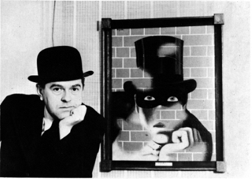
Magritte poses with his alter ego Fantomas
Rene Magritte described his paintings saying, "My painting is visible images which conceal nothing; they evoke mystery and, indeed, when one sees one of my pictures, one asks oneself this simple question, 'What does that mean?' It does not mean anything, because mystery means nothing, it is unknowable."
Here's an interesting paragraph from "Thought Rendered Visible" (by Marcel Paquet) from the History of Art: Magritte was a painter of ideas; a painter of visible thoughts, rather than of subjects. He valued neither lyrical nor the abstraction. In his view, those artists producing such work, in presenting subject-matter, were presenting nothing worthy of a single thought, nor even deserving of one's interest. Magritte did not possess a studio in the strict sense of the word [he painted in his dining room area], responding maliciously to those who commented in surprise upon this that painting was done in order that it might land on the canvas, and not on the carpet, which indeed revealed not the slightest stain. The truth is that we cannot even say with any certainty whether Magritte actually enjoyed painting. He clearly liked to think in pictures; as soon as he had elaborated these thoughts with the aid of sketches and little drawings, however, he baulked at the idea of transferring them onto canvas, preferring to go and play chess in the "Greenwich", a well-known Brussels cafe. He was not as passionate a player as Man Ray or even Marcel Duchamp (who was infuriated at losing twice in a row to an eleven-year-old boy named Fischer); nevertheless, Magritte loved this form of visible mathematics more than the act of painting. Numerous anecdotes attest to his great contempt for that which Bram Bogart called "peinture-peinture" (which may be roughly translated as "painting pretty pictures") and Marcel Duchamp the class of the "retiniens" ("retina-cretinas") - in contrast to the class of the 'grey subject-matter.' "
The above paragraph from Marcel Paquet expesses why I feel an afinity with Magritte- it's almost as if we are in some way kindred souls. If you want to get images of what exists- get a camera. Here's another example of Magritte's behavior (History of Art) that seems similar to mine:
"One day, Magritte let himself be persuaded by Georgette and a couple with whom they were friends to undertake a trip to Holland to visit an exhibition on Frans Hals, possibly the greatest master of using black in painting. Upon arriving in front of the museum, Magritte informed the others that Loulou, his little dog, did not want to see Frans Hals. And so, while his wife and their friends went round the exhibition, he waited for them in a little cafe, getting drunk on advocaat, an extremely sweet, egg-based alcoholic drink which rapidly makes one feel nauseous. He loathed so-called cultural trips. His laconic comment, upon seeing the pyramid of Cheops at Gizeh: "Yes... much as I expected." In the same way, he frequently repeated that the reproduction of a painting was all that he wanted, that he needed to see the original exactly as little as he had to read the original manuscript of books which he had read. The legacy of Dada in such jokes is unmistakable."
Magritte also liked to shock and surprise. His painting The Rape which features of a woman's face replaced by sexual attributes: breasts, belly button and pubic hair, certainly pushed the limit. To avoid a scandal this painting was hidden by a velvet curtain at the Minotaure exhibition in Brussels. My painting the Crucifixion of Christ was accepted in an exhibition in Beaufort SC and then, because of complaints, it was turned facing the wall. The reason for the complains- Christ was naked! It's a good thing Michelangelo's paintings weren't on display.
Early Life
"The void is the only great wonder of the world," said Magritte who was born in Lessines, in the province of Hainaut, in 1898, the eldest son of Léopold Magritte, a tailor, and Adeline, a milliner. November 21, 1898. But it is in "le Pays Noir" ("the Black Country": an area of coal mines and tips) that he spent most of his childhood and adolescence, particularly in the city of Châtelet, where he studied until he was almost seventeen.
His father, Léopold, born in Pont-à-Celles in 1870, was a tailor while his mother, Régina Bertinchamps, born in Gilly in 1871, was a modiste till she got married in 1898. After living in Lessines for a few months, his parents decided to settle in Gilly where his younger brothers, Raymond and Paul were born, respectively in 1900 and 1902. Paul who was a poet, a musician and a humorist, was always very close to René.
The whole family lived in Chatelet from 1904 to 1916, except for two temporary stays in Charleroi and Brussels in 1913 and 1916. They successively stayed at numbers 79 and 95 in the "rue des Gravelles" in Châtelet. We know very little in fact about René Magritte's youth, for this great artist was loath to look into his past. Thanks to Paul, we know that Léopold, the father, was a successful businessman who gave his family the opportunity of living handsomely and could even afford a small staff of servants. Léopold certainly had a sense of humour but must have been rather ill-natured.
The tragic end of Régina Magritte, whose body was recovered in the Sambre River Feb. 23, 1912, raised a lot of questions. No doubt she deeply influenced her son's work, in which water is omnipresent along with veiled characters (when Régina's body was taken away of the water, her face was covered with her dressing gown). After Régina's death, the education of the three brothers was entrusted to servants. Châtelet retains the memory of boisterous and mischievous kids, who were not particularly brilliant at school. In Charleroi, where he studied at the present "Athénée Ernest Solvay", he is remembered as a student who showed very little interest in Latin and many other branches. It is at the 1913 Fun Fair of Charleroi that he first met the one who would become his wife in 1922: Georgette Berger.
René felt an artistic calling when he took his first lessons in art, the only subject where he excelled. In his first year he produced three paintings: two landscapes (one is hung in the Rene Magritte Museum in Brussels) and a study of flowers. Eugène Paulus, the well-known sculptor, must have been one of his teachers. In 1911 René completed his first great oil painting :"Chevaux dans une pâture" (Horses in a pasture) which filled his father's heart with pride [confirmed by Magritte's autobiography]. The very first exhibition of works by René Magritte was held in the summer of 1915, in the "Château Bolle", rue de Couillet in Châtelet. This exhibition also displayed, among others, works by Albert Chavepeyer. Between 1915 and 1920, he intermittently attended classes at the Fine Arts Academy of Brussels but took far less interest in what he was being taught than in the people he met there.
In an interview Michael Georis of the newspaper Le Peuple asked Magritte, "When did you start you to draw, to paint?"
"As a very young person, around six or seven years," Magritte answered. "I attended later the Athenaeum of Charleroi and I liked much to draw and paint. My mother had died when I was very young. My father liked my drawings, my painting... He was benevolent and encouraged my vocation."
Another source says: "He began lessons in drawing around 1910 in Chatelet where his family had moved- his father was also a trader which lead to a nomadic lifestyle in search of money. Magritte's first painting, a Belgian landscape was done in 1910 and is on display at the Rene Magritte Museum in Jett, a suburb of Brussels." As a young man Magritte also wrote mystery novels (under the name Renghis- a combination of his first and middle names) and poetry. He also read mystery novels. Maybe that's why his artwork is... mysterious.
"Magritte retained few memories of his childhood in the province of Hainaut, where his parents' house in Lessines is today a little museum containing various documents. His memories were all the more vivid for being so few, however. His earliest recollection concerned a crate next to his cradle; it struck him as a highly mysterious object, and aroused in him that feeling of strangeness and disquiet which he would encounter again and again later in his adult life. His second recollection was connected with a manned hot air balloon which had landed on the roof of his parents' house. The manoeuvres undertaken by the men in their efforts to fetch down the enormous, empty bag, together with the leather clothing of the "aeronauts" and their earflap helmets, left him with a deep sensitivity for everything eluding immediate comprehension." [Marcel Paquet-History of Art]
Magritte himself speaks of the third and last childhood recollection, with which we will concern ourselves here, in a lecture given in 1938: "During my childhood, I liked to play with a little girl in the abandoned old cemetery of a country town... We used to lift up the iron gates and go down into the underground vaults. Once, on regaining the light of day, I noticed an artist painting in an avenue of the cemetery, which was very picturesque with its broken columns of stone and its heaped-up leaves. He had come from the capital; his art seemed to me to be magic, and he himself endowed with powers from above. Unfortunately, I learnt later that painting bears very little direct relation to life, and that every effort to free oneself has always been derided by the public. Millet's Angelus was a scandal in his day, the painter being accused of insulting the peasants by portraying them in such a manner. People wanted to destroy Manet's Olympia, and the critics charged the painter with showing women cut into pieces, because he had depicted only the upper part of the body of a woman standing behind the bar, the lower part being hidden by the bar itself. In Courbet's day, it was generally agreed that he had very poor taste in so conspicuously displaying his false talent. I also saw that there were endless examples of this nature and that they extended over every area of thought. As regards the artists themselves, most of them gave up their freedom quite lightly, placing their art at the service of someone or something. As a rule, their concerns and their ambitions are those of any old careerist. I thus acquired a total distrust of art and artists, whether they were officially recognized or were endeavouring to become so, and I felt that I had nothing in common with this guild. I had a point of reference which held me elsewhere, namely that magic within art which I had encountered as a child."
Rene Magritte had two brothers, Paul and Raymond, both somewhat younger than himself. Raymond, the youngest, was a clever businessman with a practical and realistic intellect; art and poetry meant nothing to him. Even after his brother's first great successes, Raymond continued to regard him as an idiot and a "nut-case". It is true that Magritte demonstrated something of an antisocial tendency; with his rebellious temperament, he found it difficult to conform to existing conventions. One day, the King wished to give a banquet in his honour, perhaps intending to commission a picture from him; Magritte rang up the master of ceremonies a few hours before the dinner was due to begin, informing him that he had unfortunately burnt a hole in his dinner jacket with his cigarette, and would therefore be unable to participate in the festivities. He soon fell out with Raymond, whom he criticized for being bourgeois and conformist; on the other hand, he always felt very close to his other brother. Paul, who studied music with ELT Mesens, wrote popular songs, composing "Le petit nid", "Quand je t'ai donne mon coeur", and arranging two works by Georgius, "J'aime ma maison" and "Je suis blase". He also composed the music for a poem by Paul Colinet, "Marie trombone chapeau buse", a minor masterpiece every bit the equal of Satie and Fargue.
History of Art: "Paul and Rene often joined forces against Raymond during their childhood; they were both extremely interested in the love affairs of their father, who knew only too well how to console himself as a widower. They also shared a boundless love for the pleasures of the cinema, avidly following the famous Fantomas series in 1913 and 1914, which had been inspired by the novel by Souvestre and Allain. Their Thursdays and Sundays were filled with the heroic deeds of this enigmatic being. Fantomas was a sinister hero without identity, totally criminal but highly popular, who in some enviable way had succeeded in becoming revered precisely because of his disgraceful deeds. There can be no doubt that this mysterious challenge to the established order and the laws of the ruling class represented a rich source of inspiration for Magritte, one which also played a role in the subject matter of some of his pictures: one thinks, for example, of such pictures as The Return of the Flame or The Threatened Assassin."
Death of his Mother- 1912
One night in 1912, his mother Régine Bertinchamp, who suffered from depression, left the house while the rest of the family was asleep and she threw herself over a bridge, into the River Sambre. Magritte (then only 13) was reportedly present when her dead body was retrieved from the water. According to one of the many legends associated with Magritte, the image of his mother floating, her nightgown obscuring her face, influenced a 1927–1928 series of paintings of people with cloth obscuring their faces, including Les Amants and The Heart of the Matter.
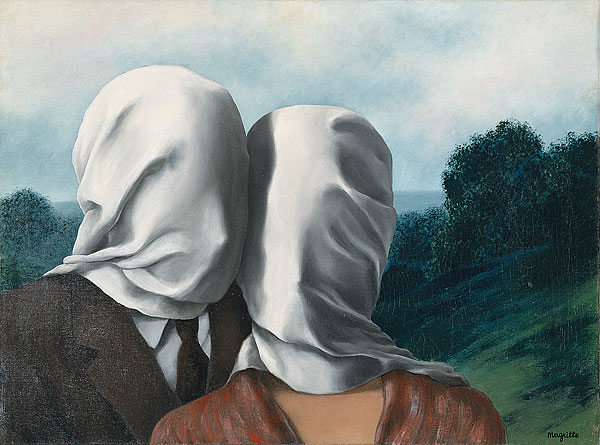
Les Amants- The Lovers (Legend associates these obscured images with his mother's suicide)
The incident was described much later by Louis Scutenaire in words which, according to Georgette, stylized the whole episode into a legend. [Scutenaire claimed he got he information from Magritte] The only recollection which Magritte himself admitted to having of the affair was that of a feeling of pride at suddenly finding himself the focal point of interest and sympathy both in the neighbourhood and among his fellow pupils at the Charleroi grammar school. It is certain that he never saw his mother's corpse, "its face covered with a nightdress." According to Marcel Paquet the "psychological interpretations of Magritte's work by David Sylvester and others that the death of Rene's mother influenced a 1927–1928 series of paintings of people with cloth obscuring their faces, including Les Amants (The Lovers; see above) and The Heart of the Matter are unfounded."
The painting that I believe deals directly with her death is his 1926 painting below, "The Musings of a Solitary Walker." Magritte used many inconic images to obscure people and objects. The reason for this had to do little or nothing to do with his mothers death. He obscured faces with sheets, then birds, pipes and finally apples. Perhaps the real reason (hinted at by Sylvester) for obscuring images besides adding mystery to the person was: the reclusive Magritte was hiding, not wanting to be recognized.
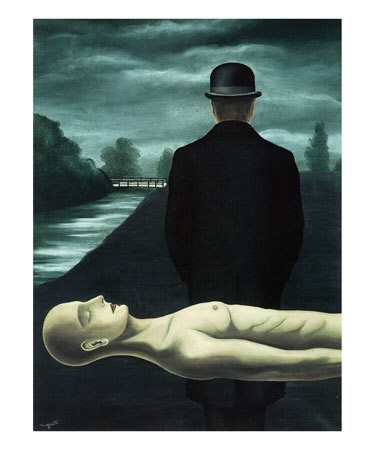
"The Musings of a Solitary Walker" 1926
Magritte Recalls His Early Work- 1915
"In 1915 I attempted to regain that position which would enable me to see the world in a different way to the one which people were seeking to impose upon me," Magritte explained. "I possessed some technical skill in the art of painting, and in my isolation I undertook experiments that were consciously different from everything that I knew in painting. I experienced the pleasure of freedom in painting the most unconventional pictures. By a strange coincidence, perhaps out of pity and probably as a joke, I was given a catalogue [Sylvester says by Pierre Bourgeois] with illustrations from an exhibition of Futurist painting. I now had before my eyes a mighty challenge directed towards that same good sense which so bored me. It was for me the same light that I had encountered as a child whenever I emerged from the underground vaults of the old cemetery where I spent my holidays."
History of Art: "In retrospect, the image of the little girl and little boy climbing out of an underground vault in which death is present, and then discovering a painter who is attempting to record his view of the cemetery on canvas, seems almost an advance announcement of Magritte's later career. The artist's childhood, and the dreams bound up with it, should not of course be regarded as the sole veritable key that enables us to gain access to the mysteries of creative output. It is clear that such pictures from the depths of the past cannot play a role in the creation of a work of art until they have been reappraised and reinvented with the help of and as a consequence of decisions taken, encounters made and coincidences experienced by the meanwhile mature artist. Given Magritte's concern to record in written form precisely this recollection, however, it is fair to assume that it contains elements which - in the manner of a kind of educative experience - serve to introduce us to the imaginary world of his work. The record of his childhood experience specifically mentions the sharp contrast between the view of the two children, who are in principle as far away as can be from the end of life, and the place where they are playing. A cemetery is the place par excellence in which one's memories of those no longer with us are preserved and cherished. It soon becomes clear that elements almost always appear in Magritte's pictures such as present a sharp contrast to each other, thereby triggering a shock which shakes the intellect out of its apathy and sets one to thinking. The simultaneity of day and night in his picture The Empire of Lights, probably his most famous work, makes this clear."
Georgette Berger 1913
At the age of 15, Magritte met Georgette Berger, the girl who would be his future wife, model and creative muse. Here's an account of the meeting from Marcel Paquet:
"The monotony of everyday life in Charleroi was interrupted not only by the pleasures of the cinema but also by the annual fair, which took place at the Place du Manege opposite the Musee des Beaux-Arts, in direct proximity to the Palais des Beaux-Arts, home of one of Magritte's most famous frescoes, The Ignorant Fairy. The fair of 1913 was to confer a lustre upon his life for ever more. A merry-go-round salon stood between the stalls and various amusements, a fairground institution which is no longer to be found. After a turn on the wooden horses, the boys and girls would walk around hand in hand, to the strains of a Limonaire organ. This merry-go-round was among those places where boys and girls met to embark upon their first flirtations. Magritte, who was fifteen that year, invited a little girl not yet even thirteen to a round: Georgette. Her father was a butcher in Marcinelle. Love was clearly already in the air at their first rendezvous: while life was to separate the two of them for some time, they would find each other again in the end, thereafter never to be parted."
Brussels 1915; The Académie Royale des Beaux-Arts
Their romance was interrupted when the Germans invaded Belgium (World War I) in August 1914 and advanced fifty miles from Mons. Rene dropped out of school. In order to continue his art studies he left he Georgette and his family behind and moved to Brussels. In November 1915 he took a room at a boarding house near the art academy (Académie Royale des Beaux-Arts) to learn how to paint with all the "proper" techniques usually attributed to artists who worked in the figurative style, his plan was to master these techniques before breaking free of them. He probably attended classes informally [supported by Sylvester] until he officially enrolled at the Academy of Fine Arts in Brussels in October 1916. Soon his family moved nearby and he moved in with them. From then until 1920 he attended classes in drawing (with Emile Vandamme-Sylva), decorative painting and ornamental composition. Biographer David Sylvester suggests that Magritte probably studied perspective using "Traite pratique de perspective" by A. Cassagne because his The Giantess (1930) and Fair Captive (study of a painting within a painting) seem to be taken from Cassagne. Some of his early works before 1919 were landscapes showing the Sambre river where his mother had committed suicide.
While studying at the Art Academy he met poet and writer Pierre Bourgeois, who became his best friend. Then in 1918 when Rene began work as a poster and advertisement designer for a wallpaper company at Peters Lacroix, he met the painter Victor Servranckx, who had already turned to non-figurative art. Magritte worked under the supervision of Servranckx and they had become friends and colaborators. In 1919, Pierre-Louis Flouquet, a French artist living in Brussels, shared his workshop with Magritte. Flouquet introduced him to other cubists and futurists; Magritte also got acquainted with the Antwerps avant-garde. Magritte’s first exhibit displayed his creations in advertising, not in painting. He exhibited two ads: one for Sherlock and the other for Monnaie Butterfly. The trade fair was organized by Víctor Bourgeois and Aimé Declerq at the Belgian Galerie Centre d’Art.
Purism; Cubo-Futurism; De Stijl (The Style) 1920
After lecture on the Dutch movement by abstractionist Theo van Doesburg titled De Stijl (The Style) in February 1920, Magritte began a series of paintings exploring those principles. Around the same time Servranckx and Magritte developed an artistic style based on purism, cubism and futurism they called Cubo-Futurism. Then in 1922 they wrote "Pure Art: A Defence of the Aesthetic." Here's an excerpt:
APPLIED ART KILLS PURE ART: The devastation caused by applied art is considerable. In order to survive many artists waste their time on the production of applied art objects which are sold on a large scale. These mediocre works tend to satisfy the aesthetic needs of mankind. As a result people lose interest in the pure works of art of these artists to the extent that they become unsaleable. Artists should be able to support themselves with their work. (Magritte and Servranckx- 1922)
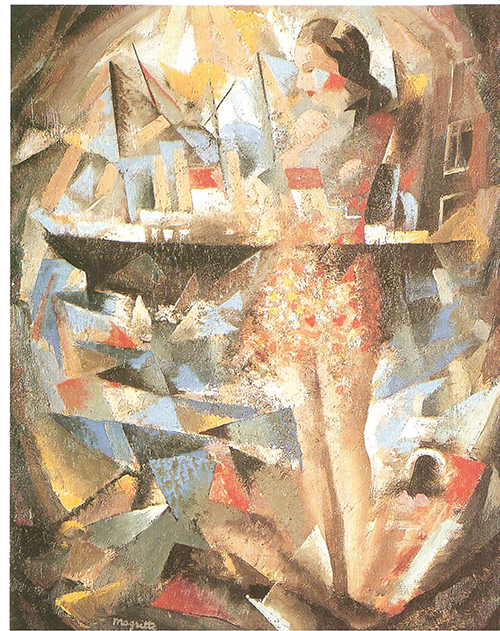
1924 Jeunesse (Youth)- Shows the influence of futurism and the Cubo-Futuristic style from the early 1920s
That same year (1922), he made one of the most important artist discoveries of his carreer in Giorgio De Chirico's pre-surrealist works (1914-1918). [Some sources give a later date for Magritte's discovery of De Chirico since Rene's style didn't change until 1925] Rene and his friend ELT Mesens were shown a reproduction of De Chirico's The Song of Love in Les Cahiers Libres and he was so moved by the image that it moved him to tears. This provided true inspiration- Magritte decided to make each of his paintings a visual poem; a quality he found present in De Chirico's works.
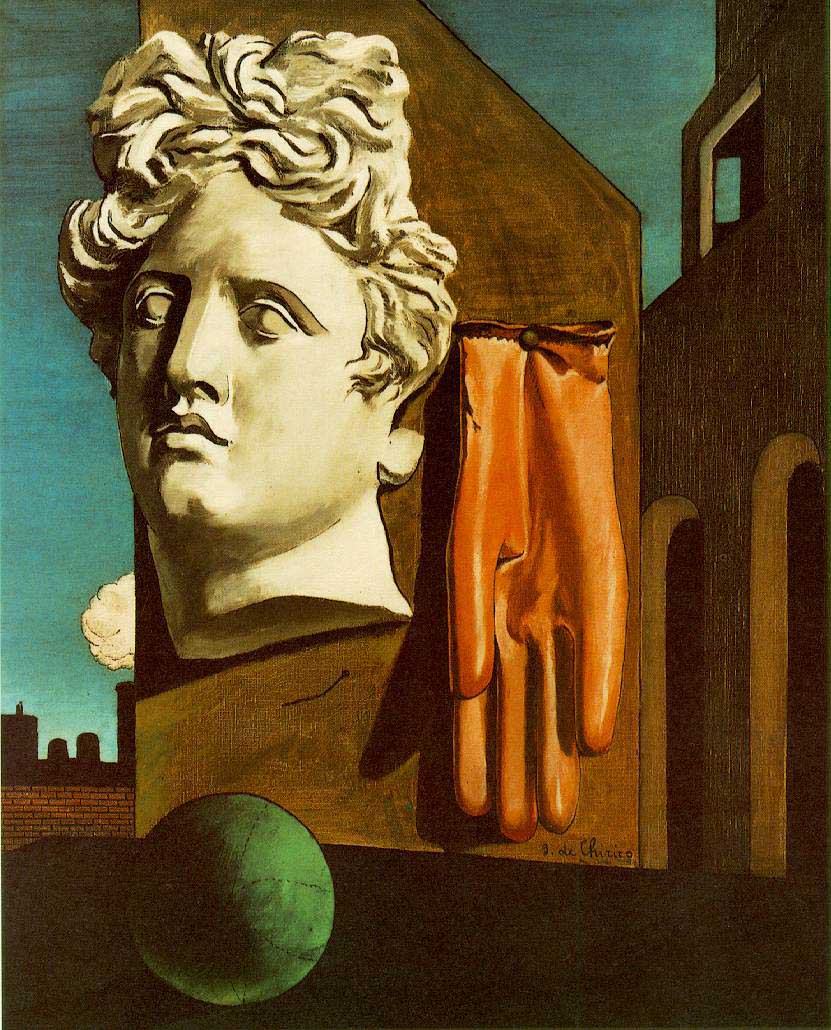
Giorgio de Chirico- The Song of Love (1914)
According to one source: "Marcel Lecomte showed Magritte a reproduction of Giorgio de Chirico's painting The Song of Love (1914), and the image (above), illustrated in the Roman periodical Valori Plastici, is said to have moved him to tears. The strange juxtaposition of objects in De Chirico's work revealed to Magritte the poetic possibilities of painting, and thereafter he adopted a similar painting style."
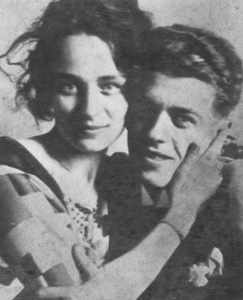
Rene and his muse Georgette
Rekindles the Fire; Enters the Military
In 1920 he met Georgette Berger again after she moved to Brussels with her sister. Georgette worked at Maison de la Culture, also as a wallpaper artist, and they rekindled their interest in each other. She became his only model and muse. Magritte's best friend the time was the young poet Pierre Bourgeois, of whom he made several portraits.
Both Pierre Bourgeois and Magritte entered the military service togther. Magritte first stint was from December 1920 until September 1921 then had another brief month in March 1922. He married Georgette in June 1922. Rene reportedly sold his first painting, a portrait of the singer Evelyne Brélia in 1923. Brelia later sang "Norine Blues," a song written by Paul Magritte with words by Rene and Georgette, at a large Norine gala.
Rene created his first really outstanding works which were characterized by Cubo-Futurist reminiscences and the presence of a very sensual representation in which women and colors are the dominant elements. He realised that resorting to abstraction has not enabled him to 'make reality manifest.' What he wanted to establish was a disturbing relationship between the world and objects as found in de Chirico's work from 1914-1918.
ELT Mesens, Dada and Surealism
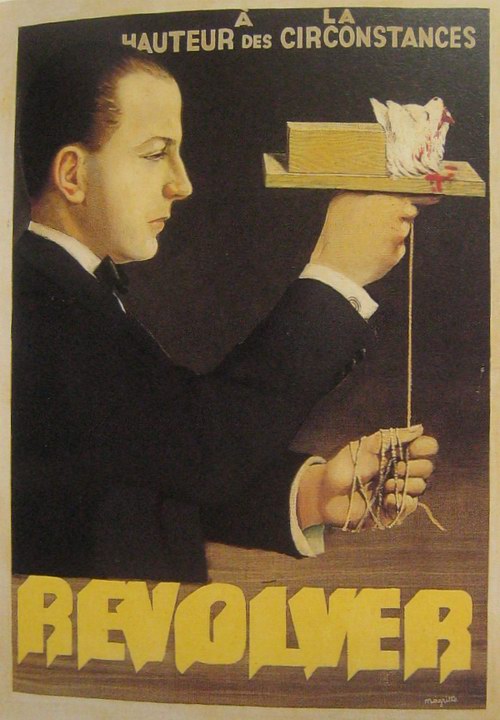
René Magritte's Portrait of E.L.T. Mesens, Rene's friend and patron
In the 1930s E. L. T. Mesens (above) moved to England and by 1936 directed the London Gallery. He suggested that the English Surrealists had never been worth their salt anyway, having always abstained from such direct action as driving horses into theatre foyers on first nights of distasteful plays, or "letting off revolvers in the street while distributing leaflets." Here's a bio of Magritte's benefactor who once bought 150 of his paintings at one time!
Fellow Belgian ELT Mesens (Edouard Léon Théodore) (1903–1971) met Magritte in 1920 and became Magritte's close friend and eventual patron. Mesens started his artistic career as a musician influenced by Erik Satie (through Rene's recommendation, Mesens became Paul Magritte's piano teacher) and an author of dadaist poems. He was a publisher of the reviews (magazines) Œesophage and Marie, both with Magritte. His activity as one of the leaders of the surrealist movement in Belgium was eased by the fact that he was owner of a gallery, where he organised the first surrealist exhibition in Belgium in 1934. He also went to co-organize the London International Surrealist Exhibition in 1936 which made him settle down in London. There he became the director of the London Gallery (which he ran during the late 30s and after World War II with Roland Penrose) and the chief editor of the London Bulletin (1938-1940) - which was one of the most important bulletins among the English-language Surrealist periodicals. A biography of Mesens by George Melly, "Don't Tell Sybil: An Intimate Memoir of E.L.T. Mesens," was published in 1997.
Magritte and Mesens were involved in many avant-garde political movements. Dada was a reaction against the politics that lead to the First World War (1916) and remained a popular artistic movement until around 1924. Both men espoused Dadaism and shortly after they met in 1920 studied Marinetti's futurism pamphets. In late 1924 the Dada movement became aligned with Surrealism and Breton's publications in October 1924. Beside political influences, the psychoanalytical dogmas of both Freud (dreams and imagery) and Jung (collective unconscious) played an important role in the imagery of dreams that was the foundation of surrealism. Surrealist leader Andre Breton went to Vienna to secure backing for the surrealist movement from Frued but failed to do so.
By the end of 1924 Magritte and E. L. T. Mesens helped form a unified Belgian Surrealist group that included Paul Nougé, Camille Goemans, and Louis Scutenaire, an early chronicler of Magritte's art. The poet Paul Nougé became the interpreter for the Belgian group of Andre Breton's Surrealist Manifesto published in October 1924. The Surrealists, who included writers and composers too, overturned conventional notions by exercising their unconscious impulses for creative effect, and Magritte's paintings often took on a bizarre, dream-like quality. Working at a rapid rate, he investigated these new non-formalist concerns.
In August 1925 the leader of surrealism and writer of the surrealist manifesto Andre Breton visited the Belgian group. Breton was not sure of Magritte's role in the new group and Rene's seemingly ordinary illustrations and paintings. As his friend the poet Paul Nougé, Magritte remained attached to Belgian Surrealism but had differences with some of Breton's points regarding automatism and actualization. Despite Breton's reservations of Rene, he eventually accepted Magritte's work and bought several of his paintings in 1928.
Dadaistic and surrealistic poetry constituted an important artistic inspiration for Magritte. In 1925 Magritte co-operated the magazines Aesophage and Marie, together with E.L.T. Mesens, Jean Arp, Francis Picabia, Schwitters, Tzara and Man Ray. His close affinity with this group of Dadaists and their regard for De Chirico helped him decide that he will only paint objects with all their visible detail by placing them in situations which are unfamiliar to the spectator and he abandoned the qualities of pictorial art in favour of a realistic style. Blue Cinema, The Window and Nocturne is one of the first works to reveal this change of emphasis. The work Nocturne contains elements from the iconography that Magritte recognises for the first time and which he will use throughout his life: the painting within a painting, the bird in flight, the fire, the stage curtain and the use of the wooden bilboquet.
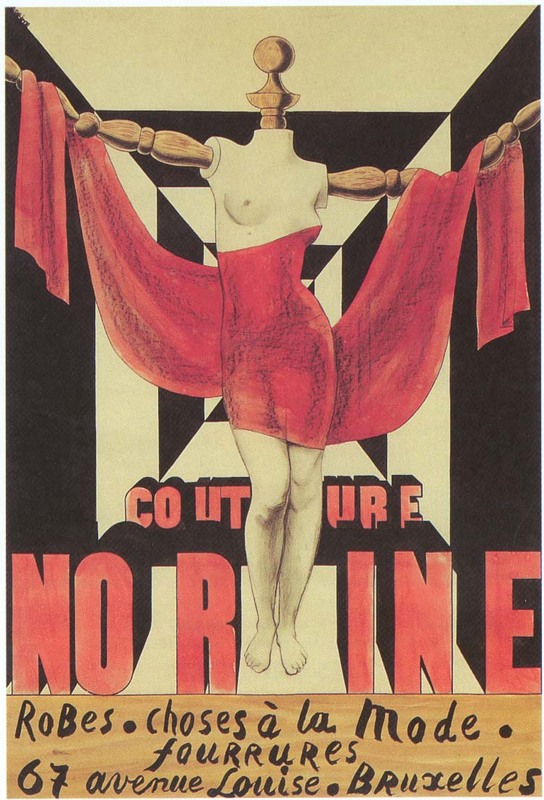
Above is Magrittes 1926 Norine Ad- note his use of the iconic bilboquet which appears in many paintings
Norine Commercial Work
Norine was run by a charismatic couple: the cultural and intellectual polymath Paul-Gustave Van Hecke, who became a patron of Magritte's art, and the grande couturière Honorine “Norine” Deschrijver. They established their couture business during World War I. For the first time, a Belgian couture house created its own designs instead of buying them from Paris, and offered an attractive and highly original local alternative. After the war, they became one of the most important couture houses in the country. Their avant-garde designs boldly transcended the modest conventionality of Belgium. The national and, to some extent, international artistic intelligentsia were their customers. The history of Belgian avant-garde fashion begins with Norine.
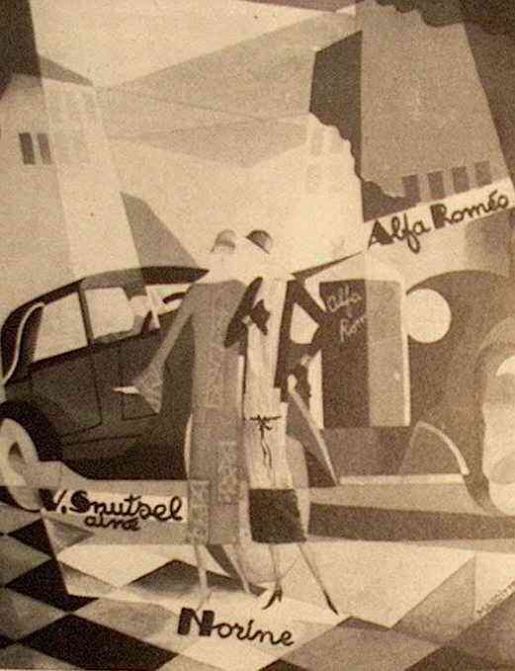
Magritte's 1924 Advertisment for Norine and Alpha-Romeo
According to one source: "Norine was a prominent representative of the Modernist movement in fashion. In fact, Van Hecke and Norine’s environment was entirely modern and was a hub of Surrealism and Expressionism: their private home, Van Hecke’s art galleries and journals and the couture house’s salons featured work by national and international contemporary artists. They firmly embedded art in fashion; this symbiosis with modern art gave their creations high art status. The couture house’s beautiful graphics were conceived by Belgian artists such as Frits Van den Berghe, Leon de Smet and—most importantly, by René Magritte. Also the techniques and imagery of modern art were literally incorporated into the house’s creations. Their signature dress of the second half of the 1920s, the “robe peinte” (painted dress) displayed hand-printed Art Deco motifs."
Magritte met Van Hecke through ELT Mesens who was Van Hecke's protege and his wife's lover. By 1924 Van Hecke began buying paintings from Rene and by the end of 1925 signed him to an exclusive contract provinding Rene with a monthly income. Van Hecke and later Mesens played important roles presenting Magritte's art and providing him with enough financial support to enable him to continue painting. By October 1926 Van Hecke reached an agreement with Galerie le Centaure; Magritte finally had a gallery to display his art.
Norine enjoyed its largest success during The Roaring 20s. Unfortunately Magritte's paid work at Norine was sporatic and he made few posters and designs. Funded at the expense of Van Hecke’s art business, the couture house survived the world economic crisis of the early 1930s. Even during World War II, they continued to be influential. The late 1940s saw the decline of Norine. After a persevering struggle for survival, the Van Heckes officially closed their couture house in 1952.
Magritte's Iconic Images
Magritte used many repeated images in his work. Because he worked as a stage or theatrical desiger, he painted many early pieces on a stage with curtains. Around 1924 he also worked doing fashion ads for Norine, hence the thin art deco figures and frequent use of mannequin like figures. He also adapted the mannequin figures from his idol, Giorgio de Chirico. In 1926 he created ads for Samuel Furriers and some paintings appeared wearing furs.
Other images he frequently used were manned ballons (from a childhood experience- also found in Giorgio de Chirico's work), the 'grelot', a spherical bell with a slit used, for example, on the harness of horses, and the bilboquet (see next section for details). He frequently used birds, eggs and apples as iconic images. By hiding or partially obscuring the object Magritte drew attention to the hidden meaning of that object. One icon he began using frequently in 1926 is the white cloth sheet which hides or partially obscures objects and people. In the late 1930s he began painting plants that morphed into birds (I call them- the war birds). Other iconic images include lions, statues (ala Venus de Milo), and bowler-hatted men (Fantomas).
Fantomas- Isidore Ducasse
The images and techniques of the movies were an influence on Magritte, especially the French film anti-hero Fantômas, a master of crime and disguise. Many of Magritte's works at this time, in keeping with Surrealist practices, disclosed a sinister side of human personality, as in Pleasure (1927) or The Threatened Assassin (1926-1927).
One main inspirational source for the Surrealists was the literature of Isidore Ducasse, alias the Comte de Lautréamont, who around 1870 had written that nothing is "as beautiful as the chance encounter of a sewing machine and an umbrella on a dissecting table." Later, in 1948, Magritte illustrated Lautréamont's complete works with 77 drawings which rivaled the text in strangeness.
Bilboquets
During the 1850's in Europe, bilbo catchers or bilboquets became quite the rage for entertainment. The one shown here is of similar design and the principle is like the ball and cup. On one end of the shaft, the ball is caught in a shallow depression, requiring considerably more practice than in the ball & cup shown above. On the other end of the shaft, the hole in the ball is stuck on the pointed "spike" of the shaft. For those that thing the action cannot be done, we watched an interpreter at a historic site succeeding about 60 percent of the time on the cup end and about one out of three times on the spike end.
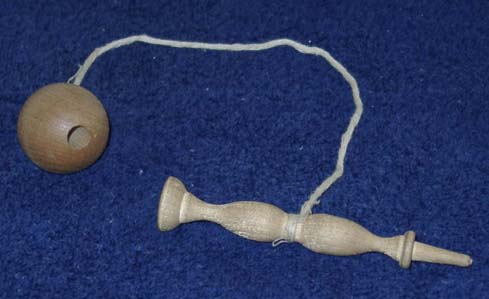
Magritte Creates His First Surreal Painting 1926- The Use of Words
Around 1925 Magritte saw two books of poems by Paul Eluard, illustrated by Max Ernst's superb collages. Magritte began producing surreal collages ala Ernst adding his own repeated images (icons) like the balluster (also called a bilboquet: resembling a chess pawn or wooden table legs) and curtains. Whether some of these collages are his first surreal works is open for debate. Magritte frequently did a collage and a painting of the same subject in 1926.
He worked as an assistant designer in a wallpaper factory, and was a poster and advertisement designer until 1926 (Sylvester says it was late 1925), when a contract with Van Hecke and Galerie la Centaure in Brussels gave him a monthly salary that allowed him to paint full-time. Magritte called the collage, The Lost Jockey, done in 1926 his first Surrealist work. "The well-known bilboquets, for example, a form of baluster or oversize playing piece to which Max Ernst gave the beautiful, vivid name of "phallustrade", turn up again in the portrait of Georgette with Bilboquet , while the picture The Bather clearly demonstrates that Magritte had abandoned the Cubist technique in favour of a manner of creating pictures that was already fully Surrealist." [from an on-line source]
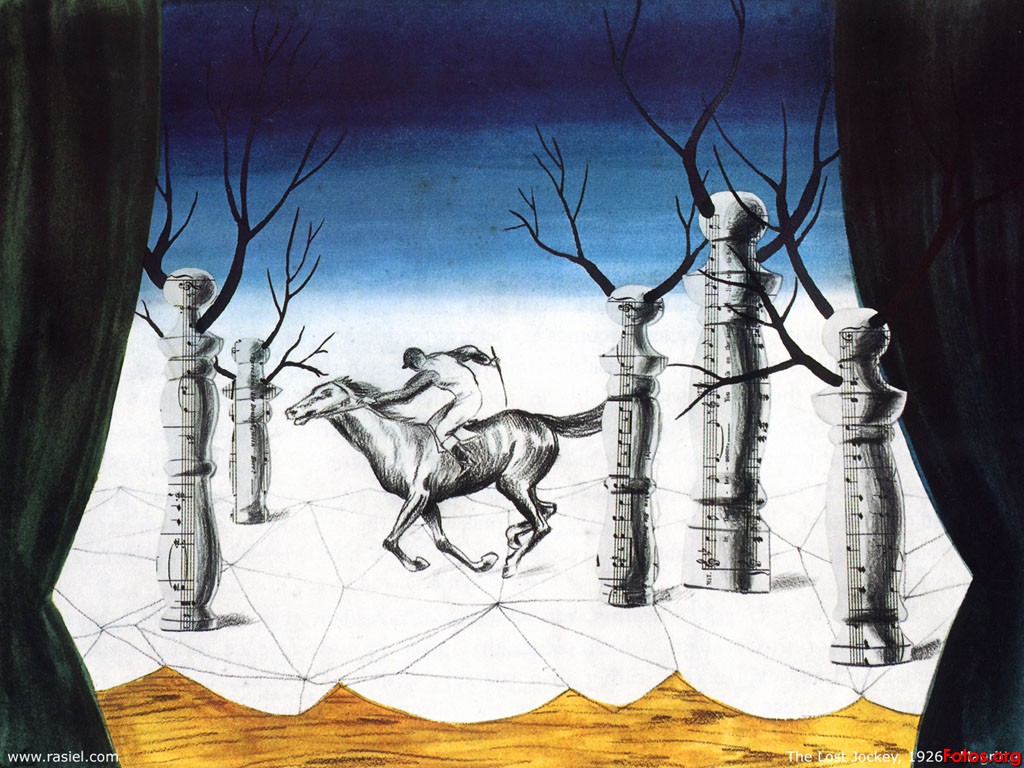
The Lost Jockey (Le jockey Perdu)- 1926 Collage version
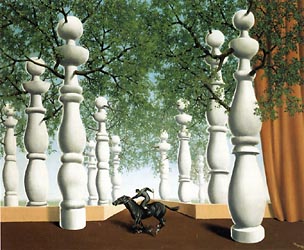
The Lost Jockey (Le jockey Perdu)- 1942
In 1926, Magritte produced what he called his first surreal painting, The Lost Jockey (Le Jockey Perdu). Magritte made both a painting and collage, the collage is superior and usually the only published version. The collage contrasted oversized balasters (resembling chess pieces) with a horse and rider. The ballusters are alive with fresh branches growing from their trunks and are set on what resmebles a giant chess board. There is a curtain on the right as if the horse is riding across the stage. The second image above is the 1942 rendition, the earlier work (seen first) is the 1926 collage.
Magritte, Nouge and Mesens were part of the nihilist dada movement. Magritte's radical mind set from the 1920s can be best understood by this amusing quote, "I detest my past, and anyone else's. I detest resignation, patience, professional heroism and obligatory beautiful feelings. I also detest the decorative arts, folklore, advertising, voices making announcements, aerodynamism, boy scouts, the smell of moth balls, events of the moment, and drunken people."
"Magritte held his first one-man exhibit was in Brussels in 1927, and as it was with his contemporaries, his art drew the ire of the critics and the conservative art crowd. But what made Magritte's work so special was his incredible skill at painting realistic objects and figures. The critics could not deny his talent, nor could they dismiss his work as an exercise in "laisser-faire". Like De Chirico, and Dali, he was a true technician, and a technician with soul. What set him apart from the other surrealists was his technique of juxtaposing ordinary objects in an extraordinary way; while Dali would "melt" a watch, playing with the consistency of an object (amongst other things), Magritte would leave objects intact, but play with their placement in reality, playing with logic. This technique is sometimes called Magic Realism. Of course, what really upset the critics was that Magritte's art did not provide answers, but only confusion, and questions as to why..." History of Art
Samuels Furrier Company 1926
Magritte and Nouge designed advertising catalogues for the Samuels Furrier Company (the first for the 1926-27 season, the second for 1928 while he was living in Paris). Magritte supplied the images and Nouge the words. [According to Marcel Marien, the words for the first Samuels catalogue were done by Camille Goemans, not Nouge]. Magritte was drawn to the artist and Surrealist center, Paris. Magritte had a steady mothly income and he didn't need to stay in Brussels to paint. After his friends Goemans and Geert van Brauene moved to Paris the Magrittes made several exploratory trips looking for possible places to stay.
Paris 1927
After Magritte's first one-man show, in Brussels in 1927, was a critical failure, he and Georgette moved to Le Perreux-sur-Marne, a suburb of Paris. Thye were unable to find a satisfactory location in the city itself. When he wasn't painting Rene began spending his time with Camille Goemans, his friend from Brussels had moved to Paris and entered the art trade with Geert van Bruaene. They began selling Magrittes and introduced him to Joan Miro, Jean Arp and Max Ernst. Magritte was still under contract with Van Hecke but still managed to slip some paintings to Goemans.
Rene, who was moved by Paul Eluard's poetry in 1925 befriended Eluard and eventually André Breton, spokesman for the movement. It was Goemans and Nouge influence that finally led to Magritte's acceptance in 1928 and Breton's acknowledgement of Magritte as a surrealist (Breton also purchased several paintings from Magritte). In 1928 Goemans and Nouge launched the review, "Distances" and Magritte illustrated some the surrealist writing of Goemans. In March 1929 he published with Magritte a series of five leaflets, Le Sens Propre (The Proper Meaning), with poems by Goemans based on the paintings and illustrations of Magritte. Goemans and Nouge helped Magritte title many of his paintings at that time. Titles were very important to Magritte and they were almost always added after the painting was completed. Magritte would mull over different ideas from his friends eventally deciding on the perfect title to add even more mystery to his image. Magritte loved verbal puns as titles as well as references to cultural, philosophical and literary figures.
By July 1929 Magritte had broken his contract agreement with Van Hecke and was waiting on Camille Goeman's new gallery to open. Goemans had a backer and was signing up artists. That summer Goemans and a friend, Yvonne Bernard, as well as René Magritte and his wife, Luis Buñuel, Paul Eluard and Gala, and the couple’s daughter Cécile headed south to Cadaqués for a month long vacation.
Salvadore Dali was in residence at his family's summer house a few miles away in Figuras [contrary to most reposts they did not stay at Dali's residence]. The Magrittes had become acquainted with Dali at Goemans' apartment while Dali stayed in Paris. During an outing, Eluard and Goemans teased Magritte about his strong Walloon accent and tried to persuade him to change it. This became a sore spot for Magritte and led to his later rejection of the Parisian art world with his 1948 "vache" period. Magritte painted "Threatening Weather" while in Cadaqués. Gala Eluard stayed with Dali after the others returned to Paris.
By 1929 Magritte was an official member of Breton's inner circle and two of his paintings and one drawing were reproduced in "Le Surrealism en 1929." Besides his drawings Magritte contributed his article "Words and Images" (Les Mots et les Images) to the final issue of Breton's "La Revolution Surrealist." His painting, The Hidden Woman, was used for its famous cover which shows a photo montage of the leading members with their eyes closed (below).
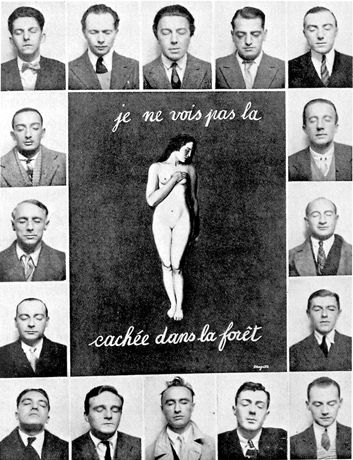
I Do Not See the (Woman) Hidden in the Forest- Cover featuring Magritte's "Hidden Woman"
This final issue contained Breton's Second Surrealist Manifesto. Magritte's photo is on the right column, second from the bottom. Magritte had a rocky relationship with Breton over the years and generally disregarded Breton's Fruedean interpretations.
"Psychoanalysis has nothing to say, not even about works of art, which evoke the mystery of the world," said Magritte. "Perhaps psychoanalysis itself represents the best case for psychoanalysis." Magritte regarded it as a pseudo-science of the unconscious, a criminological and ideological starting point. As Michel Foucault - with whom Magritte had an interesting and instructive correspondence in the 1960s - succinctly explained, psychoanalysis aims at finally confirming existential repression by restricting desire to the family triangle, to the legally legitimized married couple.
In psychoanalysis, love always means Daddy, Mummy and me! Magritte was his own Surrealist once writing: "Happy is he who betrays his own convictions for the love of a woman." He opposed Freud's theses, automatist experiences based upon the power of the unconscious, and everything that all too often in the circle around Andre Breton, the artist, threatened to become dogma and law. It was unavoidable that those artists who were obviously permeated by Surrealism would be excluded sooner or later from the Surrealist movement. Andre Masson had realized this, and himself demanded his own exclusion. Breton's reply to this was remarkable: "Why? I have never exerted any pressure upon you." "Proof, retorted Masson, "that you have exerted it upon others." Magritte, for his part, to whom Breton had written indignantly in the late 1940s, "Your dialectics and your Surrealism enplein soleil are threadbare", answered, "Sorry, Breton, but the invisible thread is on your bobbin."
Words as Images
While in Paris Magritte had started using written words on his canvases. According to David Sylvester over 20% of his paintings (over 40 paintings) done in Paris were word-paintings. The first series of word paintings included his 1927 masterpiece "The Interpretation of Dreams." His most famous word painting "The Treachery of Images" (Treason of Images) was probably done in the spring of 1929.
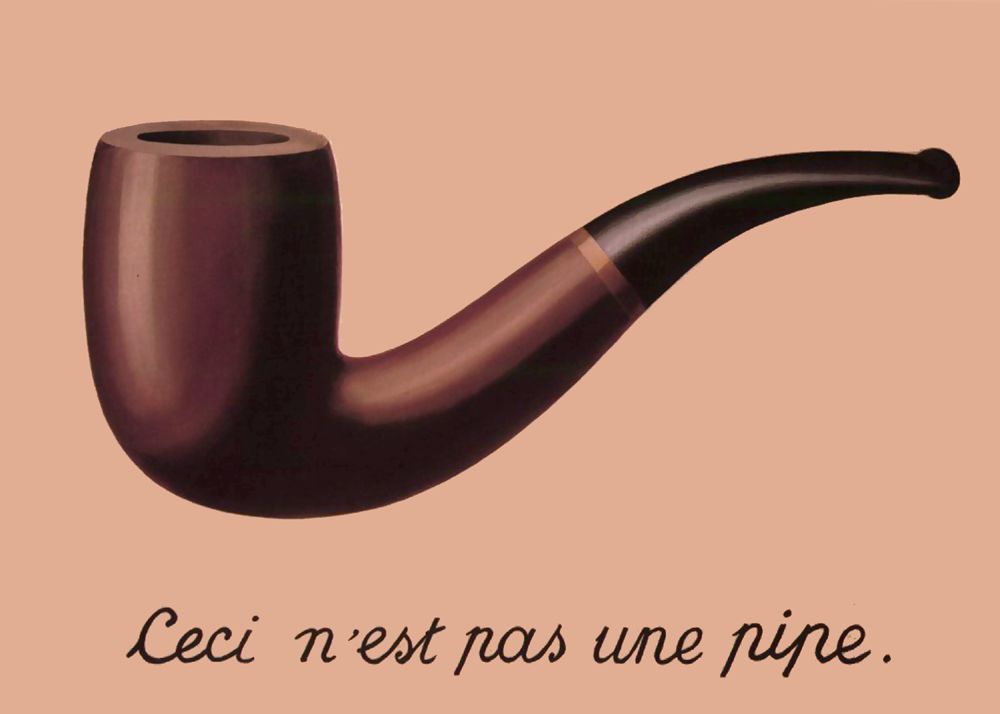
Magritte did a drawing of the idea in January 1929. Biographer Sylvester suggests the idea may have come from Le Corusier's photo of a profile captioned "Co-operative: The Pipe." The joke may have come from a placard Geert van Brauene displayed in the Brussels Galerie du Parlement: "This is Not Art."
Magritte painted below his pipe "This is not a pipe" (Ceci n'est pas une pipe), which seems a contradiction, but is actually true: the painting is not a pipe, it is an image of a pipe. When Magritte once was asked about this image, he replied, "Of course it was not a pipe, just try to fill it with tobacco."
Magritte used the same approach in a painting of an apple: he painted the fruit realistically and then used an internal caption or framing device to deny that the item was an apple. In these Ceci n'est pas works, Magritte points out that no matter how closely art comes to depicting an item realistically, it is never the item itself.
The Break From Paris-The incident with Breton- 1929
On Dec. 14th, 1929 Magritte and Georgette were attending a dinner party at Andre Breton's house, when Breton made a comment about a cross Georgette wore around her neck, a family keepsake. According to legend Breton (there are different versions of this event) asked that she remove the cross. The Magritte's quickly left the party and the incident cause a riff between them and Breton. This incident isolated them from the Paris surrealists and the Magritte's moved back to Brussells six month later. This version has been reported over the years by various authors including Suzi Gablik and Pollizotti [and is confirmed by Sylvester]. This minor mishap may have been the final stone in the strained relationship between Breton and the Magrittes. The Belgium group led by Paul Nouge although tied to the Paris group differed in ideology especially in regard to automatic writing and painting. The Magritte's friendship with Eluard whose wife Gala left him for Dali also helped deepen the riff between the Magrittes and the Parisian group since Dali was now becoming a central figure.
Here's a different account of the December 14th incident from History of Art: One evening, when Georgette and Rene Magritte were in a taxi with Paul Eluard on their way to a meeting of the Surrealist group, Eluard drew Georgette's attention to the small golden cross which she was wearing around her neck, advising her to hide it since Breton would be sure to take offence at it. She refused, and "The Pope" [Breton] indeed made reference to the un-Surrealist character of the object, prompting Magritte to decide that he and his wife would forthwith stay away from these meetings. The whole affair had blown over by the next day, however, and the Magrittes continued to attend the gatherings, along with Breton, Dali, Miro, Max Ernst and the others, while Georgette went on wearing the keepsake from her mother around her neck. With regard to relations within the group, persistent legends occasionally have a tendency to magnify small, harmless disagreements out of all proportion."
Magritte still remained in Paris waiting to have a one-man exhibition at Goemans in the Spring. The problem was Paris was in the midst of recession after the 1929 collapse on Wall Street. The effect of the economic crisis became all too apparent to the artist when his friend Camille Goemans was forced to close his Paris gallery in April 1930. Goemans was homeless and was forced to stay with the Magrittes until May when he returned to Brussels.
Many collectors and galleries became bankrupt. Magritte no longer has a steady income from Van Hecke and Georgette wanted to go home. Discouraged, Magritte waited until he rasied the money (he sold eleven paintings to Mesens) then in July the Magritte's returned to Brussels.
135 Esseghem Street, Jette (outskirts of Brussels)- July 1930
After Rene Magritte and his wife Georgette moved back to Belgium they eventually settled at 135 Esseghem Street, a ground floor apartment, where they would live for over two decades. When they arrived in 1930, the artist was 32, and stayed until 1954 when they moved to Schaerbeek, a suburb to the east of Jette. Magritte had spent three productive years in Paris and had met and working with the leading members of the surrealist movement, such as Andre Breton and Salvador Dali.
Jette is now squeezed between the district of Heysel, with its stadium, and the "royal" suburb of Laeken (so called because it's the Belgian royal family's here, a splendid palace closed to the public). But in the 1930s, it was on the edge of the countryside. Magritte made his home here in order to be close to his brother, Paul, a pianist, and to his wife's sister and brother-in-law. He rented the ground-floor flat in order to have a garden for his dogs. In the back he made use of the space to build a studio. From here, he and his brother Paul ran their own advertising company, Studio Dongo. They produced illustrations, advertising artwork and covers for musical scores as a means of making money while Magritte was selling few of his paintings.
The decorative taste in the house, which is now the Rene Magritte museum, reflects Magritte's love of colour, with walls of pink and green, and a wardrobe and wooden chest, both designed by Magritte and painted bright red. Magritte made extensive use of his surroundings when he painted. The fireplace, the doors separating the sitting room from the bedroom, the windows at the front of the house, all feature in his paintings. The staircase was used, too, although in real life, unlike art, it leads to the floor above rather than coming to an abrupt halt.
The years spent in Jette were among Magritte's most prolific, and artistically his most creative, even though he met with little financial success. He painted half of his 1,600 canvases in the modest dining room that doubled up as his studio, and was also the centre of the Belgian surrealist movement.
Studio Dongo 1931-1935
Magritte was back in Brussels by the end of July 1930. The small amount of money he received from Mesens to move back to Brussels had evaporated but they were back among family and friends. These were the difficult Great Depression years (1930-1935) and Rene and his brother Paul soon set up an advertising company, Studio Dongo, named after Fabrice Del Dongo.
Advertising soon turned into a full-time professional activity but the ads were secondary: Magritte took it up only because of his financial difficulty. Unfortunately, some of Magritte’s projects were rejected, and he destroyed some of his work himself. Frustrated, he suffered from depression and began to hate his advertising job.
The Studio Dongo advertisements faithfully follow the rules of advertising: their messages are neutral and simple. Magritte’s only concern was for efficacy, transparency, and clarity, and this is reflected in the simplicity of the ads, which simply feature the name of the brand and an illustration.
It was in the dining room-studio that he painted most of the time and where he created nearly half of all his paintings and gouaches. It was in this modest room that Magritte’s most creative period took place, which led to many masterworks. And that's why several elements of the house are integrated in the painter’s works.
The Rene Magritte Museum
The 135, Esseghem Street, now a museum, was also the headquarter of the Belgian surrealists. The painter’s friends met here weekly and organized all kinds of performances. These meetings resulted into many subversive activities, books, magazines and tracts. It was in this house that Magritte knew his “Renoir” period, his “Vache” period and negotiations regarding exhibitions in museums. All these activities are illustrated on the first and second floors of the museum by original works, documents, objects, letters and photos. On the third floor, one can have a view of the painter’s attic. Besides, some 30 drawings, gouaches, paintings of Magritte punctuate the journey, among which "Olympia", "La lampe d'Aladin" or "Lola de Valence", one of the best pieces of his "période vache".
This house which Magritte left in 1954 was restored between 1993 and 1999 and became a museum to pay a permanent homage to one of the most brilliant artists of all time.
Magritte's Paintings 1930s
Although Magritte exhibited twice at the Palais des Beaux-Arts in Brussels in the 1930s (a one-man show of 59 works in 1933, followed by a group show with Man Ray and Yves Tanguy in 1937), he was temporarily left without a commercial outlet for his paintings after the closure of Le Centaure in 1930. The gallery’s stock of 150 recent paintings by Magritte was purchased by his old friend E. L. T. Mesens.
In 1933, Magritte defined his artist intentions by stating that the primary aim of his work from that point on would be to reveal the hidden and often personal affinities between objects, rather than juxtaposing unrelated objects. He continued to remain in contact with Breton and Eluard in Paris, contributing to the final two issues of "Le Surrealisme" and remained associated with surrealism in general throughout his career.
Soon Magritte's output increased due to the sponsorship of Claude Spaak, who he met in 1931. Spaak was a playwright, but had also been an active collector of Magritte's paintings for some time. In 1935, he made a semi-formal arrangement to allow Magritte to abandon commercial work and focus fully on his own artistic output. To this end, he provided the artist a monthly stipend, while also guaranteeing the paintings he produced. In addition to this, Spaak actively sought other sponsors for Magritte.
When Edward James took over Magritte's Dongo Studio company around 1936, Magritte quit and devoted himself entirely to painting. Thanks to his English patron and ELT Mesens' London exhibits, Magritte’s art came to be recognized internationally. Consequently, when companies began to contact Magritte, it was the not the advertiser they wanted to hire; they were after the painter. It isn't surprising to find that some of the Belgian artist’s ads were inspired directly by his canvases. For example, the design used for a New York perfume company, Mem, is an elaborate version of his painting La clef des songes.
Although he admired de Chirico, who found poetry in the combination of normally unrelated objects, Magritte preferred to examine unexpected encounters between objects already in some way associated with each other. In the winter of 1932–3, for instance, he painted a birdcage containing an enormous egg, titling it Elective Affinities (priv. col.; see Waldberg, p. 228), after Goethe’s novel Die Wahlverwandtschaften (1809). Often taking his titles from literature, films and musical scores on the completion of the picture, he invited friends, notably the writers Paul Nougé and Louis Scutenaire, to make suggestions.
While the titles of his first Surrealistic paintings maintained a certain logic in relation to the imagery, from the 1930s words and images gradually acquired greater independence from each other, often retaining only an associative link. For example, he entitled a miniature reproduction in plaster of the Venus de Milo, a torso admired as the expression of feminine beauty in spite of the fact that it has no arms, the Copper Handcuffs (h. 370 mm, 1936; Paris, Charles Ratton priv. col.; see 1978–9 exh. cat., no. 200). Magritte continued to make frequent use of abstract forms, particularly in paintings that included texts, such as Bel Canto (1938; priv. col.; see Waldberg, p. 166), until the late 1930s. As a means of broadening the range of association, he sometimes represented an object undergoing metamorphosis into something else, as in the Red Model (1935; e.g. Stockholm, Mod. Mus.; Paris, Pompidou), in which the pointed toes of a pair of boots become the toes themselves. Such strategies, drawing attention to the relationship between inanimate and living objects, were similar to those employed by other Surrealists
The Human Condition, 1935- The Painting Within a Painting
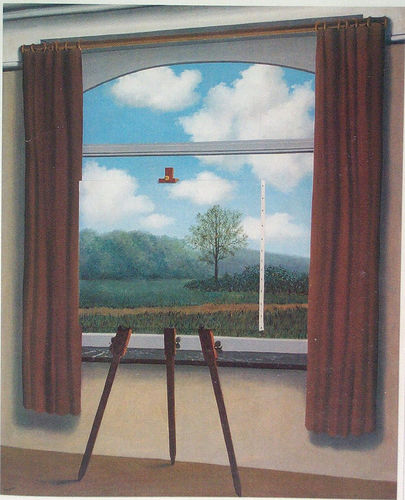
The Human Condition- 1935
Magritte challenges the difficulty of artwork to convey meaning with a recurring motif of a painting on an easel (painting within a painting), as found in his La Belle Captive series (from 1931) and his The Human Condition series (1933, 1935). The ideas for the "painting within a painting" probably came from De Chirico's 1917 Great Metaphysical Interior and also his studies at the Art Academy. He began experimenting with the "painting within a painting" as early as 1925 but didn't use the same image. His early "painting within a painting" used the painting as a separate reality- an open door to another dimension.
Later his The Promenades of Euclid (Where Euclid Walked- 1955) features the spires of a castle are "painted" upon the ordinary streets outside the window the canvas overlooks. He wrote to André Breton about The Human Condition that it was irrelevant if the scene behind the easel was different than what was depicted upon it, "but the main thing was to eliminate the difference between a view seen from outside and from inside a room." The windows in these pictures are framed with heavy drapes, suggesting a theatrical motif. Just as theatre reflects our lives, or ideal replications of our lives, to an audience simultaneously familiar and unfamiliar with the situation, so does Magritte's artwork.
London
Edward James was an eccentric poet, collector, and patron of both Dalí and Magritte. In 1935 James visited Salvador and Gala at their home in Catalonia. Dali was invited to London to help decorate the Monkton house in Chelsea with surreal furnishings and paintings. Through an introduction from Dali, Magritte also was consulted about the interior designs. The famous lobster telephone came from James collaborations at that time. James remained an important supporter and collector of Magritte's work and Magritte stayed at his house on several occasions in London.
Man Ray exhibited with Magritte in Trois peintures surrealistes: Rene Magritte, Man Ray, Yves Tanguy at the Palais des Beaux-Arts in Brussels, December 1937. ELT Mesens moved to London and on April 1, 1938 the London Gallery reopened under his directorship. Mesens managed to organize solo exhibitions at the Gallery for many of his surrealist friends including Magritte. Mesens gallery mission statement read "painters of the surrealist movement will be the principle feature of this gallery."
The first Surrealist Exhibition took place in London in July 1936. In 1937 Magritte was visited back to London by James to add surreal elements to his house on Wimpole St. The paintings by Magritte included La Modele Rouge II, La Jeunesse Illustre, and two portraits of James, one of which was La Reproduction Interdite.
1939-1940 Marital Difficulties- World War II Approaches
On his trips to London to visit James and Mesens to prepare for his exhibitions, Rene had an affair with the young surrealist model known as the "Surrealist Phantom" of 1936, the artist Sheila Legg (in her mid-20s), who posed for surrealist events with Dali and others and was one of the most photographed surrealist woman at the time. Apparently this started in March 1937. As a result, Magritte made several visits to London in order to work in connection with Legg. According to one source: "Magritte, in fact, fell in love with her."
A 1936 Time Magaszine article reported: [Highlight of the exhibition was Artist Salvador Dali's living design, Phantom of Sex Appeal, for which Artist Sheila Legge solemnly glided through the crowded, stuffy gallery in a tight white satin gown, her head in a wire cage covered with pink paper rosebuds, a facsimile female leg in her hand. She had substituted the leg for a pork chop as prescribed by Artist Dali.
"That get-up," a bystander whispered, "must be very hot." "Very," admitted Phantom Legge.]
Legge, who was very hot in more ways than one, was also pursued by ELT Mesens, close friend of Magritte and Director of the London Gallery. Mesens wanted her to be his secretary.
Magritte still loved Georgette deeply and did not want to hurt her or arouse her suspicions. He arranged for his friend, Paul Colinet (1898-1957) a Belgian surrealist poet, to spend time with Georgette and keep her entertained while Rene was away. During one of his London trips, Georgette and Paul Colinet had an affair. Georgette, much to everyone's astonishment, pursued her affair and at one point asked Rene for a divorce. David Sylvester, Magritte's biographer and cataloguer, reported that Magritte made a scene when he confronted Georgette with the aide of a policeman.
Rene Magritte fled Brussels and his marital problems for France in May 1940, five days after German troops invaded Belgium and Holland. Georgette did not go with him. Magritte spent three months in Carcassonne, France,
with Paul Eluard and Scutenaire. When conditions allowed, Magritte returned to Brussels and reconciled with Georgette. At this point Magritte became depressed and experimented with different styles to escape his emotional demons and the German occupation of his country.
1940s- A Time of Change- "Sunlit Period" 1943
In order to show the Nazi aggression in Europe and the coming World War, Magritte continued a series of paintings that began with the 1937 The Black Flag (Le Drapeu Noir) and The present (Le présent) 1939. His 1940 painting, Homesickness, surely is a reflection on the problems he had experienced and the Nazi occupation. In 1942 he began paint the leaf-birds which we see in two works from 1942, Treasure Island and The Companions of Fear.
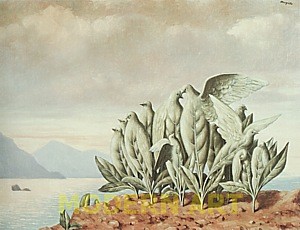
Treasure Island- 1942; featuring The War Birds
Within a year he became obsessed by a reproduction of Pierre Auguste Renoir's Bathers which started his impressionistic transformation. His new style was called "Surrealism in full sunlight" (Torczyner 186) or the "Sunlit" (also "Renoir") period.
Enticed by the sensuality of the colors, he opted for a more luminous palette. His objects and figures were looser lacking the meticulousness detail for which he was known, unleashing color in new, warmer and more cheerful tonalities. The evocative titles are The First Day (Le Premier jour), The Harvest (La Moisson) and The Goad (L' Aiguinon).
Marcel Mariën elaborated on this work of Magritte:
"Fired with enthusiasm, Magritte immediately went on to make other versions, including ‘The dance’ (a standing nude), and ‘The harvest’ (a reclining nude), and then concluded the experiment by taking the solution to its peak of refinement, since he performed the same transformation on Ingres’s La Source, an ‘academic’ representation if ever there was one, by not only adorning the young girl’s body with different colours, but by re-creating the whole picture according to the technique of the Impressionists! And Nougé, who had already supplied the titles for the previous versions, was to name this last experiment, the subversive profundity of which remains as usual unnoticed by everyone else: Monsieur Ingres’s good days."
Perhaps of more significance to the history of Belgian Surrealism, though, is that Marcel Marien was responsible for the first monograph on Magritte, published in 1943, and for the subsequent study on the artist, Les Corrections naturelles, which appeared in 1947. Marien also claimed that during this time because of the bleak economic times, painted forgeries of the works of other masters and that Marcel sold some of these paintings (the claim has not been documented).
In the 1940s Magritte again joined the communist party, which he had joined for the third time. Magritte's political involvement was based essentially upon his spirit of opposition. All of his poster designs were rejected on principle by the party leadership, and he could not bear having to subordinate his art to an ideological party line, even one so broadly conceived. "There is no more reason for art to be Walloon than for it to be vegetarian", was his reply to those seeking to enlist him for exhibitions aimed at demonstrating regionalist interests. Ultimately, his sole, his real banner was the mystery inherent in objects, in the world, that mystery which belongs to everyone and to no one.
September 1944: Brussels Liberated
The Belgium capital of Brussels was liberated by Allied forces on September 3, 1944. The Allies liberated the Belgium port of Antwerp, an important port. Magritte's Applied Dialectics (Lo Dialectique appliquee) 1944-1945 is one of the few paintings that directly deals with the war. Most of his paintings like his Treasure Island series use the symbolic war birds to imply German aggression.
The first three paintings are from the 1942 period, then it's clear his style has changed. In 1945 he began to do paintings in his old style as well. His manifesto Surrealism in full sunlight, which he concocted in 1946 with the complicity of Marcel Mariën, Paul Nougé, Louis Scutenaire, Joë Bousquet, Jacques Michel and Jacques Wergifosse, a prelude to the manifestoes of extramentalism and amentalism, is an instrument of warfare directed against the magic, esoteric ideology into which André Breton had strayed. “We have neither the time nor the taste to play at Surrealist art, we have a huge task ahead of us, we must imagine charming objects which will awaken what is left within us of the instinct to pleasure.”
The riff began when Magritte accompanied by Marcel Marien went to Paris in 1946 to meet with Breton to show his new work. Breton was not impressed and his close friend ELT Mesens didn't approve of his new "sunlit period" which Magritte argued was "the need in this post-war world to emgere from darkness." [Sylvester p. 208] Magritee added, "Against the general pessimism I uphold the quest for joy and pleasure."
Breton replied in a letter, "I can assure you that not one of your latest pictures gives me the impression of sunlight (Renir, yes)..." To justify his change in direction Magritte wrote "Le Sureallisme en plein soleil" and circulated the draft to various surrealists for support. Later in 1946 Breton published a list of the various surrealist painters and left Magritte off the list- he later listed Magritte as one of the "surrealists despite themselves."
In 1946 Magritte issued his manifesto Surrealism in full sunlight, saying, “We have neither the time nor the taste to play at Surrealist art, we have a huge task ahead of us, we must imagine charming objects which will awaken what is left within us of the instinct to pleasure.” Clearly Magritte was trying to justify the detour from his sucessful painterly style.
Although his "sunlit" Renior styled paintings began in 1943, all his work was not impressionist. At the start of 1947 Margritte was painting in both his realist style and his impressionist style. Some of his works (Intelligence; A Thousand and One Nights) were already headed toward more extreme colors. This extreme style, closer to some of Van Gogh works, would accelerate in late 1947 when he was invited to hold his first solo exhibition in Paris at the Galerie du Faubourg in May 1948. He had waited twenty years to do a solo show in Paris and was resentful at the lack of appreciation that he felt the Parisian surrealists gave him. Magritte wrote at the time: "The paintings of Picabia should not make us dream of the revelations to be gleaned from coffee dregs, or prophesies..."
Alexander Iolas 1947
Then in 1947 Alexander Iolas, who became Magritte's principal dealer in the United States, successfully exhibited the artist's work in New York. Iolas then suggested that Magritte forget Renoir and sunlight to focus his output on images which overwhelmingly appealed to the public, like Treasure Island.
ELT Mesens helped organize the American exhibits with Iolas through a series of letters starting in 1946. Alexander Iolas (1907-1987) was born in Alexandria, Egypt, on March 25, 1907, to Andreas and Persephone Coutsoudis, who were Greek. In 1924, he went to Berlin as a pianist, and later became a ballet dancer who toured extensively with the Theodora Roosevelt Company and later with the company formed by the Marquis de Cuevas. In the 1940s, he ran a gallery in New York City promoting Max Enrst, Andy Warhol, Matta, Victor Brauner, Joseph Cornell, Yves Klein and Niki de Saint-Phalle. He also had galleries in Paris, Milan and Geneva. Although he promoted new work by unknown artists, Iolas was able to reassure the potential clients with his magnetic personality; his sharp dress and mischievous and sometimes irresistible charm.
Magritte's "Vache" Period 1947-1948
With some international recognition and success through Alexander Iolas, Magritte was not impressed by his invitation to hold his one man show at the Galerie du Faubourg, Paris. As a joke concocted by Magritte and his friends, Rene painted a series of hilarious pictures to exert a bit of revenge upon the Paris art world. Magritte experimented with a brash Fauve-inspired style in late 1947 dubbed "Vache" (literally, cow), which he premiered at an exhibition at the Galerie du Faubourg in Paris the next year.
According to Bernard Marcadé: "In French, the term vache is used for an excessively fat woman, or a soft, lazy person. An unpleasant person is described as a peau de vache (cow-skin); amour vache (cow-love) refers to a relationship more physical than emotional. It thus treads a line between vulgarity and coarseness, and that is what characterises this set of paintings and gouaches, representing a radical departure from the painter’s neutral, detached style which had finally been accepted by Parisian Surrealist orthodoxy. Overall, the striking thing about these works is their garish tones, their exuberant, grotesque and caricatured subjects, all executed rapidly and casually in the name of a freedom from aesthetic and moral injunctions and prescriptions."
Paris Exhibit: May, 1948
"The exhibition was accompanied by a small catalogue with a preface by the poet Louis Scutenaire, bearing an evocative title (“ 9been putLes pieds dans le plat” – Putting one’s foot in it) and written in a slangy style, which is clearly in line with Magritte’s intentions. Moreover, Scutenaire would admit as much some years later: “The important thing was not to enchant the Parisians, but outrage them.” The triviality of the works actually wrong-foots Surrealist good taste. Both text and images are placed on a deliberately rustic and provincial register. “We’d been fed-up for a good long time, we had (been put), deep in our forests, in our green pastures.” Traditionally, the Belgians are seen as coarse peasants by the French, including the intellectuals." [Bernard Marcadé]
"The tone is set. Scut’ and Mag’ (their signatures, indicating their friendship and complicity) have decided to turn this exhibition into a kind of explosive manifesto against the arrogance and pedantry of the sycophants of the ideology advocated by André Breton. “The moment had come to strike a great blow,” Scutenaire would explain in retrospect. The two associates laid it on the line, The works shown in Paris joyfully mix comedy, viciousness and coarseness of the most scatological kind. In this respect they continue the visual counterpart to the three tracts that Magritte published in 1946 along with Marcel Mariën (The Imbecile, The Pain in the Arse, The Sod), in which one could already read a supreme contempt for all kinds of convention. Pictorial Content is probably the painting in the series which best allegorises Magritte’s desire to attack the pictorial practices with which he himself had engaged up until that point. It is no longer resemblance that is brought to the fore here, but an excess of distortion and a stridency of colour." Bernard Marcadé
I'm sure his Belgian group had a laugh at the outrageous paintings he produced for the show. Using the broad strokes and colors of Van Gogh he churned out a series of unsual paintings, some outrageous. The show in May at the Galerie du Faubourg was a failure, the French were not pleased. At the suggestion of his wife, Georgette and his principal dealer in the United States, Alexander Iolas, Magritte decides to abandon his "experiment" and return to his realistic style of the 1930s.
After signing a contract in 1948 with Alexandre Iolas, the New York dealer who would remained his agent until Rene's death, Magritte dedicated himself to producing the type of mysterious works that he would eventually lead to his international fame.
After Vache 1949
Magritte completed Megalomania in 1948 which reveals similarities with The Marches of Summer (1938-1939): a female torso (now in three parts), weightless cubes, blue sky with clouds and a parapet. The Domain of Arnheim, a work originally painted in 1936 is repainted in 1949 using the broken window illusion. Magritte enjoys the game of juxtaposing and manipulating motifs. An image could exercise such powers of seduction that the painter felt compelled to reproduce it many times. Rather than falling into repetitive indifference, he excels in revisiting work in this way. Nowhere is this more evident than in 1949 The Dominion of Light, an evocation of the simultaneous presence of day and night, a magnetization of the contradictions dear to the Surrealists. There are sixteen versions of this work.
In 1949 he published thè manifesto "Le Vrai Art de la peinture," in which he wrote, "The perfect painting produces an immense effect only for a very short time," and "The art of painting is an art of thinking, whose existence underlines the importance of the role held in life by the eyes of the human body' (translation - Modern Art, Thames and Hudson 1974). Central to Magritte's art is his conviction that the role of painting is not to represent but to stimulate a reaction at an altogether deeper level.
1950s
During the period of 1950-1960 Magritte produced some of his most important works. In 1949 he started his casket series "Perspective: The Balcony By Manet" and followed with "Madame Recamier de David." in this series he copied the masters paintings exactly replacing the human figures with caskets. At his art dealer Iolas urging he continued painting different versions of his early paintings including the 1949 version of The Domain of Arnheim. he produced many versions of his most famous painting "Empire of lights" beginning in 1949.
By 1950 he started his petrification (turning live objects into stone) paintings including The Given Word (La Parole Donnee) The Wasted Footsteps, The Song of Violet, The Magic Potion (Le Philtre) and first "Memory of a Journey" painting. The entire scenes are petrified and according to Magritte "only the light of the candle is real." In 1953 he began to be identified by his bowler-hatted figures with his La Golconde, featuring bowler-hatted men raining from the sky. The early 1950s saw the "Art of Conversation" series with giant block letters and his "oversized everyday objects" series with the 1952 "Personal Values." Another series started in the 1950s was his "defiance of gravity" series found in the Battle of Argonne and other 1950s works. Multiplication (repeated objects) was an important effect in Magritte's paintings including Spontaneous Generation, Golconda, The Golden Legend and The Month of the Grape Harvest.
In October 1957 Magritte met Harry Torczyner (1910-1998), a Belgian lawyer based in New York who was interested in poetry and art. Torczyner became Magritte's patron, friend and adviser for the rest of Rene's life. Around the same time (1956) Magritte met Barnet Hodes, a successful Chicago lawyer with a keen interest in Surrealism and in collecting, who over the next ten years was his patron. Hodes commissioned sixty small gouches of Magritte's early work. Magritte eventually secured a contract with Alexander Iolas to the main body of his production in exchange for an annual stipend. With his financial prospects secure, the Magrittes moved to 97, rue des Mimosas, Brussels-Schaerbeek in 1957, where he remained until his death.
In the 1950s Magritte also took on a number of major mural commissions. In 1951 at the Theatre Royal des Galeries Saint-Hubert in Brussels he painted the ceiling with a blue sky filled with white clouds and his favorite icons, blue bells (grelots) inside of a large pink border. The mural is reminiscent of his The Curse (Malediction) sky-blue with clouds paintings. The next major commission was a giant mural in eight panels for the Casino at Knocke-le-Zoute, 1951-1953 titled "The Enchanted Realm" which was a recreation of many of his most famous paintings icons and images. Magritte produced eigth model oil paintings (see all below) and images of the eight paintings were reproduced beginning on July 4 by a team of painters under Magritte's supervision. In 1957 he created a version of "La Fée ignorante" (The Ignorant Fairy) from his 1950 painting of the same name which appears the Hall of Congress of the Palais des Beaux-Arts de Charleroi (1957). In 1961 he designed a mural for Palais de Crogress titled "les barracade mystereouses."
Magritte's fame was on the rise; he was given major retrospective exhibitions in Brussels (1954) and in 1956 he was awarded the Guggenheim Prize for Belgium.
Later Years 1960-67
By 1960 Rene Magritte was an internationally acclaimed artist. He was identified by his paintings of bowler hated men, a personae of his hero Fantamas that he created when he was a young radical. Magritte still considered himself to be a secret agent, a mysterious figure identified by his dark attire and bowler hat. His hobbies were amateur cinematography and chess, and he enjoyed taking walks with his wife and his dog, Lou-Lou. Now 63 he said, "I'm getting older; I get toothaches and headaches, and there's nothing I can do about it." Magritte lived in a comfortable unbohemian house near Brussels, quietly damning a good deal of what other artists were doing. Although famous, his paintings did not command the high prices in the 1960s as some other leading surrealist artists like Dali.
In 1961 he continued doing murals and designed a mural for Palais de Crogress titled "Les Barracade Mystereouses." Around this time he began doing limited editions lithographs. With sales from his lithographs and paintings he was finally financially secure he said, "I have everything I need." Magritte painted regularly until his death. Around 1963 he discovered he had cancer and his health began to fail. He traveled with Georgette spending some time in Ischia, Italy, in April 1965. Despite his health problems in 1965, the Magrittes took their first trip to the U.S.A. on the occasion of the retrospective held at the Museum of Modern Art of New York.
Magritte refered to his work of this latest period (1958-1965) as his 'found children'. The iconographic elements, between them, in a reverting manner, finished by binding everything together in the last ten years of Magritte's life. In 1966 he spends Christmas and New Year's Eve in Cannes, with his beloved Georgette, and in 1967, he has a retrospective in Rotterdam, Holland, and an exhibit at the Iolas Gallery in Paris. In early 1967, after a personal exhibition in Paris, René Magritte undertook the making of eight sculptures. But he didn't have the time to see his works cast into bronze; he indeed died of pancreatic cancer at his home on August 15, 1967, eleven days after the opening of a retrospective of his works at the Boijmans-van Beuningen Museum of Rotterdam.
Rene Magritte, two months before his death, wrote Sarane Alexandrian a splendid letter in which he said: "I conceive of the art of painting as the science of juxtaposing colours in such a way that their actual appearance disappears and lets a poetic image emerge. . . . There are no "subjects", no "themes" in my painting. It is a matter of imagining images whose poetry restores to what is known that which is absolutely unknown and unknowable."
Magritte continued painting until 1967, the year of his death, leaving an unfinished painting (below- see last painting) on his easel. The work had been commissioned by a young German collector from Cologne, who wanted "something in the nature of Empire of the Lights; he was destined never to take possession of the picture he had ordered. The uncompleted painting would remain on its easel in the painter's house in Brussels until the death of Rene's beloved Georgette in 1986.
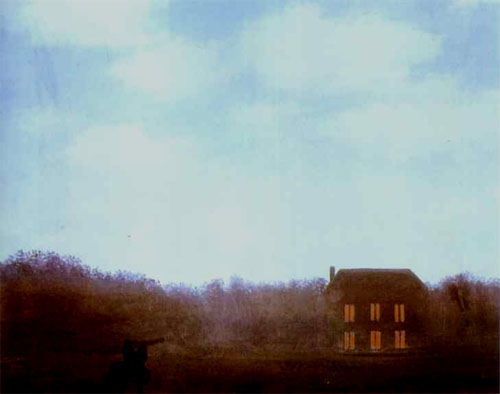
Magritte's last unfinished painting: The Empire of the Lights- 1967
Popular interest in Magritte's work rose considerably in the 1960s, and his imagery has influenced pop, minimalist and conceptual art. In 2005 he came 9th in the Walloon version of De Grootste Belg (The Greatest Belgian); in the Flemish version he was 18th.
René Magritte described his paintings by saying, "My painting is visible images which conceal nothing; they evoke mystery and, indeed, when one sees one of my pictures, one asks oneself this simple question, "What does that mean?" It does not mean anything, because mystery means nothing either, it is unknowable."
Titles
The influence of the Fantomas figure also played a significant role in Magritte's selection of titles for his pictures. Patrick Waldberg has been able to provide evidence of the considerable importance of the titles of Magritte's pictures within his work as a whole, where their purpose may be seen as providing a counterpoint to realistic perception. For instance, the woman in the feathered hat, her face hidden by a bunch of violets, should be seen as The Great War, as an incessant conflict with that which is visible, where each object always hides another. In revealing itself, an object simultaneously conceals itself, thereby functioning as the curtain for another. Magritte was always deeply conscious of this tightrope walk between revelation and masking. Things have a flip side, a reverse, which is even more curious and fascinating than their manifested form, the facade presented to everyone, their face; and it was this reverse, this dark side, which Magritte so subtly captured and rendered visible, in defiance of all logic. Accordingly, the titles of his pictures never serve to describe or identify. On the contrary, they bring some additional infringement, some further false trail, into play, the function of which is to create a confrontation within language and the logic of words, one analogous to the confrontation arising out of the painted picture. Magritte's work is certainly representational, and yet, at the same time, it constitutes an incessant attack upon the principle of reproduction in art. What his figures thereby lose in identity, they gain in mystery and otherness. Mystery finds its way into the everyday in Magritte's art, while subversive thought becomes gentle custom. Joy is constant; every moment is a festival.
In Popular Culture
The 1960s brought a great increase in public awareness of Magritte's work. One of the means by which his imagery became familiar to a wider public was through reproduction on rock album covers; early examples include the 1969 album Beck-Ola by the Jeff Beck group (reproducing Magritte's The Listening Room), Jackson Browne's 1974 album, Late for the Sky, with artwork inspired by Magritte's L'Empire des Lumières, and the Firesign Theatre's album Just Folks . . . A Firesign Chat based on The Mysteries of the Horizon. Alan Hull of UK folk-rock band Lindisfarne used Magritte's paintings on two solo albums in 1973 and 1979. Styx adapted Magritte's Carte Blanche for the cover of their 1977 album The Grand Illusion, while the cover of Gary Numan's 1979 album The Pleasure Principle, like John Foxx's 2001 The Pleasures of Electricity, was based on Magritte's painting Le Principe du Plaisir.
Jethro Tull mentions Magritte on a 1976 album and Paul Simon's song "Rene And Georgette Magritte With Their Dog After The War" appears on the 1983 album Hearts and Bones. Paul McCartney, a life-long fan of Magritte, owns many of his paintings, and claims that a Magritte painting inspired him to use the name Apple for the Beatles' media corporation. Magritte is also the subject and title of a John Cale song on the 2003 album HoboSapiens.
The Son of Man, 1964
Numerous films have included imagery inspired by Magritte. The Son of Man, in which a man's face is obscured by an apple, is referenced in the 1992 film Toys, the 1999 film The Thomas Crown Affair and in the 2004 short film Ryan. In the 2004 film I Heart Huckabees, Magritte is alluded to by Bernard Jaffe (Dustin Hoffman) as he holds a bowler hat. According to Ellen Burstyn, in the 1998 documentary The Fear of God: 25 Years of "The Exorcist", the iconic poster shot for the film The Exorcist was inspired by Magritte's L'Empire des Lumières.
The Spanish television show El Planeta Imaginario (1983–1986) dedicated two episodes to René Magritte: "M, el extraño viajero" (M, the strange traveller) and "La Quimera" (The Chimera).
Magritte's painting The Treachery of Images is referred to in The Forbidden Game: The Chase, a book by L. J. Smith, in which the difference between image and reality becomes key to solving the entire conflict. The same painting (and its caption, "This is not a pipe") inspired a graphic in the video game Rayman Raving Rabbids. The online game Kingdom of Loathing refers to this painting, as well as to The Son of Man.
Artists influenced by Magritte
Contemporary artists have been greatly influenced by René Magritte's stimulating examination of the fickleness of images. Some artists who have been influenced by Magritte's works include John Baldessari, Ed Ruscha, Andy Warhol, Jasper Johns, Vija Celmins, Marcel Broodthaers and Martin Kippenberger. Some of the artists' works integrate direct references and others offer contemporary viewpoints on his abstract fixations.
Selected Works in Chronological Order
1920 Landscape
1922 The Station and L'Écuyère
1923 Self-portrait, Sixth Nocturne, Georgette at the Piano and Donna
1925 The Bather and The Window
1926 The Lost Jockey, The Mind of the Traveler, Sensational News, The Difficult Crossing, The Vestal's Agony, The Midnight Marriage, The Musings of a Solitary Walker, After the Water the Clouds, Popular Panorama, Landscape and The Encounter
1927 Young Girl Eating a Bird, The Oasis (started in 1925), The Meaning of Night, Let Out of School, The Man from the Sea, The Tiredness of Life, The Light-breaker, A Passion for Light, The Menaced Assassin, Reckless Sleeper, La Voleuse, The Fast Hope, L'Atlantide and The Muscles of the Sky
1928 The Lining of Sleep (started in 1927), Intermission (started in 1927), The Flowers of the Abyss, Discovery, The Lovers I & II[1] [2], The Voice of Space, The Daring Sleeper, The Acrobat's Ideas, The Automaton, The Empty Mask, Reckless Sleeper, The Secret Life and Attempting the Impossible
1929 The Treachery of Images (started in 1928), Threatening Weather and On the Threshold of Liberty
1930 Pink Belles, Tattered Skies, The Eternally Obvious, The Lifeline, The Annunciation and Celestial Perfections
1931 The Voice of the Air, Summer and The Giantess
1932 The Universe Unmasked
1933 Elective Affinities, The Human Condition and The Unexpected Answer
1934 The Rape
1935 The Discovery of Fire, The Human Condition, Revolution, Perpetual Motion, Collective Invention, The False Mirror and The Portrait
1936 Clairvoyance, The Healer, The Philosopher's Lamp, Spiritual Exercises, Portrait of Irène Hamoir, La Méditation and Forbidden Literature
1937 The Future of Statues,The Black Flag, Not to be Reproduced, Portrait of Edward James and Portrait of Rena Schitz, On the Threshold of Liberty
1938 Time Transfixed, The Domain of Arnheim and Steps of Summer
1939 Victory
1940 The Return, The Wedding Breakfast and Les Grandes Espérances
1941 The Break in the Clouds
1942 Misses de L'Isle Adam, L'Ile au Tréson, Memory, Black Magic and The Misanthropes
1943 Universal Gravitation and Monsieur Ingres's Good Days
1944 The Good Omens
1945 Treasure Island, Les Rencontres Naturelles and Black Magic
1946 L'Intellience and Les Mille et une Nuits
1947 The Cicerone, The Liberator, The Fair Captive, La Part du Feu and The Red Model
1948 Blood Will Tell, Memory, The Mountain Dweller, The Art of Life, The Pebble, The Lost Jockey, God's Solon, Shéhérazade, L'Ellipse and Famine and The Taste of Sorrow
1949 Megalomania, Elementary Cosmogany, and Perspective, the Balcony
1950 Making an Entrance, The Legend of the Centuries, Towards Pleasure, The Labors of Alexander, The Empire of Light II, The Fair Captive and The Art of Conversation
1951 David's Madame Récamier (parodying the Portrait of Madame Récamier), Pandora's Box, The Song of the Violet, The Spring Tide and The Smile
1952 Personal Values and Le Sens de la Pudeur
1953 Golconda, The Listening Room and a fresco for the Knokke Casino
1954 The Invisible World, The Explanation and The Empire of Light
1955 Memory of a Journey and The Mysteries of the Horizon
1956 The Sixteenth of September
1957 The Fountain of Youth and The Enchanted Domain
1958 The Golden Legend, Hegel's Holiday, The Banquet and The Familiar World
1959 The Castle in the Pyrenees, The Battle of the Argonne, The Anniversary, The Month of the Grape Harvest and The Glass Key
1960 The Memoirs of a Saint
1962 The Great Table, The Healer, Waste of Effort, Mona Lisa (circa 1962) and L'embeillie (circa 1962)
1963 The Great Family, The Open Air, The Beautiful Season, Princes of the Autumn, Young Love, La Recherche de la Vérité and The Telescope
1964 Evening Falls, The Great War, The Son of Man and Song of Love
1965 Carte Blanche, The Thought Which Sees, Ages Ago and The Beautiful Walk (circa 1965)
1966 The Shades, The Happy Donor, The Gold Ring, The Pleasant Truth and The Mysteries of the Horizon
1967 Les Grâces Naturelles, La Géante, The Blank Page, Good Connections, The Art of Living and several bronze sculptures based on Magritte's previous works.